The Role of the Food Banks in Saving Freshwater Resources through Reducing Food Waste: The Case of the Food Bank of Navarra, Spain
Abstract
:1. Introduction
2. Materials and Methods
2.1. Research Strategy and Water Footprint Assessment
2.2. Scenario Analysis: Data Collection and Data Analysis
2.2.1. Scenario with the Food Bank of Navarra
2.2.2. Scenario without the Food Bank of Navarra
3. Results
3.1. Water Footprint of the Food Bank of Navarra
3.2. Water Use in a Scenario without the Food Bank of Navarra
3.3. Comparative Analysis of the Green, Blue and Grey Water Footprints “with” and “without” the Activities Food Bank of Navarra
4. Discussion
4.1. Implications of the Study
4.2. Limitations of the Study
4.3. Recommendations
5. Conclusions
Author Contributions
Funding
Acknowledgments
Conflicts of Interest
Appendix A
| Energy Source | Conversion Factor (Blue WF m3/Energy Unit) | Unit | Source |
|---|---|---|---|
| Solar | 3090 | GWh | [28] |
| Mini-hydroelectric | 10,000 | GWh | [28] 1 |
| Diesel | 0.03 | GJ | [30] |
| Petrol | 0.08 | GJ | [30] |
| Cogeneration | 684 | GWh | [28] |
| Gas | 580 | GWh | [50] 2,3 |
| Carbon | 1552 | GWh | [28] |
| Wind power | 1.7 | GWh | [51] 3 |
| Hydroelectric | 40,814 | GWh | [28] |
| Nuclear | 1569 | GWh | [28] |
| Source of Consumption | Conversion Factor (Green WF m3/Unit) | Unit | Source |
|---|---|---|---|
| Wood | 0.2 | Kg of sawn lumber | [35] 1 |
| Cardboard | 171.9 | Ton of cardboard | [35] 1 |
| Energy Source | Source | Considered Water Use |
|---|---|---|
| Landfill | [52] 1 | 58.5 m3 of grey water per ton of dumping in landfills |
| Paper and cardboard | [53] | 24 m3 of blue water per ton of recycled paper |
| Composting | MCP, Arazuri 2 | 0 m3 considering closed composting |
| Biomethanization | E-cogeneración cabanillas and HTN Biogas 3 | 0 m3 |
| Light packaging | Sernaplas | 0 m3 |
| Glass | FCC ámbito | 0 m3 |
| Reject | - | - |
| Other | - | - |
| Food Category | Source Consulted for the Water Footprint Estimation |
|---|---|
| Fruits | [41] |
| Vegetables and legumes | [41] |
| Canned vegetables and legumes | [41] |
| Dairy products | [40] |
| Unclassified food | Weighted average |
| Beverages | [40,41,54] |
| Prepared dishes | [40,41,55] |
| Pastries, cookies and sweets | [40,41] |
| Condiments and sauces | [40,41] |
| Cereals, flour, bread and pasta | [41] |
| Meats | [40] |
| Snacks | [41] |
| Canned fruits | [41] |
| Eggs | [40] |
| Cocoa and chocolates | [41] |
| Coffees and infusions | [41] |
| Fish | [41] |
| Nuts | [41] |
| Children’s food | [41] and weighted average |
References
- The Food and Agriculture Organization of the United Nations (FAO). Global Food Losses and Food Waste-Extent, Causes and Prevention, Rome. 2011. Available online: http://www.fao.org/3/i2697s/i2697s.pdf (accessed on 15 November 2021).
- European Commission. Communication from the Commission, The European Green Deal; European Commission: Brussels, Belgium, 2019. [Google Scholar]
- Ministerio de Agricultura; Pesca y Alimentación. Anteproyecto de ley de Prevención de las Pérdidas y el Desperdicio Alimentario; Spanish Ministry of Agriculture, Fisheries and Food: Madrid, Spain, 2021.
- Makov, T.; Shepon, A.; Krones, J.; Gupta, C.; Chertow, M. Social and environmental analysis of food waste abatement via the peer-to-peer sharing economy. Nat. Commun. 2020, 11, 1156. [Google Scholar] [CrossRef] [PubMed]
- The Global FoodBanking Network. 2021. Available online: https://www.foodbanking.org/what-we-do/ (accessed on 15 November 2021).
- Francis-Devine, B.; Danechi, S.; Tyler, G. Food Poverty: Households, Food Banks and Free School Meals; House of Commons Library: London, UK, 2021. [Google Scholar]
- Amicarelli, V.; Lagioia, G.; Bux, C. Global warming potential of food waste through the life cycle assessment: An analytical review. Environ. Impact Assess. Rev. 2021, 91, 106677. [Google Scholar] [CrossRef]
- Scherhaufer, S.; Moates, G.; Hartikainen, H.; Waldron, K.; Obersteiner, G. Environmental impacts of food waste in Europe. Waste Manag. 2018, 77, 98–113. [Google Scholar] [CrossRef] [PubMed]
- Tonini, D.; Albizzati, P.F.; Astrup, T.F. Environmental impacts of food waste: Learnings and challenges from a case study on UK. Waste Manag. 2018, 76, 744–766. [Google Scholar] [CrossRef] [PubMed]
- Kummu, M.; de Moel, H.; Porkka, M.; Siebert, S.; Varis, O.; Ward, P. Lost food, wasted resources: Global food supply chain losses and their impacts on freshwater, cropland, and fertiliser use. Sci. Total Environ. 2012, 438, 477–489. [Google Scholar] [CrossRef]
- Blas, A.; Garrido, A.; Willaarts, B.A. Food consumption and waste in Spanish households: Water implications within and beyond national borders. Ecol. Indic. 2018, 89, 290–300. [Google Scholar] [CrossRef]
- Marston, L.T.; Read, Q.D.; Brown, S.P.; Muth, M.K. Reducing Water Scarcity by Reducing Food Loss and Waste. Front. Sustain. Food Syst. 2021, 5, 85. [Google Scholar] [CrossRef]
- Hoekstra, A.Y.; Mekonnen, M.M. The water footprint of humanity. Proc. Natl. Acad. Sci. USA 2012, 109, 3232–3237. [Google Scholar] [CrossRef] [PubMed] [Green Version]
- Reynolds, C.; Piantadosi, J.; Boland, J. Rescuing Food from the Organics Waste Stream to Feed the Food Insecure: An Economic and Environmental Assessment of Australian Food Rescue Operations Using Environmentally Extended Waste Input-Output Analysis. Sustainability 2015, 7, 4707–4726. [Google Scholar] [CrossRef] [Green Version]
- Aldaya, M.M.; Armijos, A.; Soret, B. La Huella de Carbono de las Actividades del Banco de Alimentos de Navarra. 2020. Available online: https://bancoalimentosnavarra.org (accessed on 15 November 2021).
- Guilhem, J. Rapport Sur L’empreinte Environnementale Liee a L’activite de La Banque Alimentaire de Bordeaux & de La Gironde en 2015; Veolia: Bordeaux, France, 2016. [Google Scholar]
- Grupo de Investigación Eco-Efficient Cropping Systems de la Universidad de Córdoba. Estudio de la Huella de Carbono del Banco de Alimentos Medina Azahara de Córdoba; Grupo de Investigación Eco-Efficient Cropping Systems de la Universidad de Córdoba: Córdoba, Spain, 2020. [Google Scholar]
- European Environment Agency. Use of Freshwater Resources in Europe, Indicator Assessment. 2021. Available online: https://www.eea.europa.eu/data-and-maps/indicators/use-of-freshwater-resources-3/assessment-4 (accessed on 15 November 2021).
- Jodar-Abellan, A.; López-Ortiz, M.I.; Melgarejo-Moreno, J. Wastewater Treatment and Water Reuse in Spain. Current Situation and Perspectives. Water 2019, 11, 1551. [Google Scholar] [CrossRef] [Green Version]
- Downward, S.R.; Taylor, R. An assessment of spain’s programa AGUA and its implications for sustainable water management in the province of Almería, southeast Spain. J. Environ. Manag. 2007, 82, 277–289. [Google Scholar] [CrossRef]
- Soto-García, M.; Martínez-Alvarez, V.; García-Bastida, P.A.; Alcon, F.; Martin-Gorriz, B. Effect of water scarcity and modernisation on the performance of irrigation districts in south-eastern Spain. Agric. Water Manag. 2008, 95, 458–468. [Google Scholar] [CrossRef]
- Fernández, J.M.; Selma, M.A.E. The dynamics of water scarcity on irrigated landscapes: Mazarrón and Aguilas in south-eastern Spain. Syst. Dyn. Rev. 2004, 20, 117–137. [Google Scholar] [CrossRef]
- Canales-Ide, F.; Zubelzu, S.; Rodríguez-Sinobas, L. Irrigation systems in smart cities coping with water scarcity: The case of Valdebebas, Madrid (Spain). J. Environ. Manag. 2019, 247, 187–195. [Google Scholar] [CrossRef] [PubMed]
- Garrido, A.; Llamas, M.R.; Varela-Ortega, C.; Novo, P.; Rodríguez-Casado, R.; Aldaya, M.M. Water Footprint and Virtual Water Trade in Spain: Policy Implications; Springer: New York, NY, USA, 2010. [Google Scholar] [CrossRef]
- Hoekstra, A.Y.; Chapagain, A.K.; Mekonnen, M.M.; Aldaya, M.M. The Water Footprint Assessment Manual: Setting the Global Standard; Water Footprint Network; Earthscan: London, UK, 2011. [Google Scholar]
- Pellegrini, G.; Sillani, S.; Gregori, M.; Spada, A. Household food waste reduction: Italian consumers’ analysis for improving food management. Br. Food J. 2019, 121, 1382–1397. [Google Scholar] [CrossRef]
- Gobierno de Navarra. Reglamento de Saneamiento de las Aguas Residuales de Navarra. 1988. Available online: http://www.lexnavarra.navarra.es/detalle.asp?r=28754 (accessed on 15 November 2021).
- Hardy, L.; Garrido, A. Análisis y evaluación de las relaciones entre el agua y la energía en España. In Papeles de Agua Virtual; Fundación Marcelino Botín: Santander, Spain, 2010; Volume 6. [Google Scholar]
- Hofstrand, D. Liquid Fuel Measurements and Conversions; Iowa State University of Science: Ames, IA, USA, 2008. [Google Scholar]
- Berger, M.; Pfister, S.; Bach, V.; Finkbeiner, M. Saving the Planet’s Climate or Water Resources? The Trade-Off between Carbon and Water Footprints of European Biofuels. Sustainability 2015, 7, 6665–6683. [Google Scholar] [CrossRef] [Green Version]
- Natural Resources Canada. Fuel Consumption Guide. 2018. Available online: https://www.nrcan.gc.ca/sites/www.nrcan.gc.ca/files/oee/pdf/transportation/tools/fuelratings/2018%20Fuel%20Consumption%20Guide.pdf (accessed on 15 November 2021).
- Australian Bureau of Statistics. Table 6 Average Rate of Fuel Consumption, by State/Territory of Registration by Type of Vehicle by Type of Fuel-Period 1, Sub-Annual Motor Vehicle Use Estimates, July 2018 to June 2019. 2019. Available online: https://www.abs.gov.au/statistics/industry/tourism-and-transport/survey-motor-vehicle-use-australia/latest-release#articles (accessed on 15 November 2021).
- Ministerio del Interior, V.4.1. Parque de Vehículos, Distribuidos por Provincias, Tipos y Carburantes. Año 2018., in Parque de Vehículos-Anuario-2018 Archivo xlsx. 2018. Available online: https://www.dgt.es/es/seguridad-vial/estadisticas-e-indicadores/parque-vehiculos/tablas-estadisticas/2018/ (accessed on 15 November 2021).
- Ministerio para la Transición Ecológica y el Reto Demográfico. Gestión de residuos, in Mitigación: Políticas y Medidas. 2012. Available online: https://www.miteco.gob.es/es/cambio-climatico/temas/mitigacion-politicas-y-medidas/gestion-residuos.aspx (accessed on 15 November 2021).
- Schyns, J.F.; Booij, M.J.; Hoekstra, A.Y. The water footprint of wood for lumber, pulp, paper, fuel and firewood. Adv. Water Resour. 2017, 107, 490–501. [Google Scholar] [CrossRef]
- Jefferies, D.; Muñoz, I.; Hodges, J.; King, V.J.; Aldaya, M.; Ercin, A.E.; Canals, L.M.i.; Hoekstra, A.Y. Water Footprint and Life Cycle Assessment as approaches to assess potential impacts of products on water consumption. Key learning points from pilot studies on tea and margarine. J. Clean. Prod. 2012, 33, 155–166. [Google Scholar] [CrossRef] [Green Version]
- Gobierno de Navarra. Residuos Domésticos y Comerciales, Inventario 2018; Gobierno de Navarra: Pamplona, Spain, 2019.
- Gobierno de Navarra. Oficina de Prevención de Residuos y de Impulso de la Economía Circular, Limitaciones que Abren Puertas. 2018. Available online: https://oprec-navarra.com/limitaciones-abren-puerta/ (accessed on 15 November 2021).
- Gobierno de España. Decreto 2484/1967, de 21 de Septiembre, por el que se Aprueba el Texto del Código Alimentario Español; Gobierno de España: Madrid, Spain, 2021.
- Mekonnen, M.M.; Hoekstra, A. A Global Assessment of the Water Footprint of Farm Animal Products. Ecosystems 2012, 15, 401–415. [Google Scholar] [CrossRef] [Green Version]
- Mekonnen, M.M.; Hoekstra, A.Y. The green, blue and grey water footprint of crops and derived crop products. Hydrol. Earth Syst. Sci. 2011, 15, 1577–1600. [Google Scholar] [CrossRef] [Green Version]
- Goossens, Y.; Wegner, A.; Schmidt, T. Sustainability Assessment of Food Waste Prevention Measures: Review of Existing Evaluation Practices. Front. Sustain. Food Syst. 2019, 3, 90. [Google Scholar] [CrossRef]
- Stöckli, S.; Niklaus, E.; Dorn, M. Call for testing interventions to prevent consumer food waste. Resour. Conserv. Recycl. 2018, 136, 445–462. [Google Scholar] [CrossRef]
- Reynolds, C.; Goucher, L.; Quested, T.; Bromley, S.; Gillick, S.; Wells, V.K.; Evans, D.; Koh, L.; Kanyama, A.C.; Katzeff, C.; et al. Review: Consumption-stage food waste reduction interventions—What works and how to design better interventions. Food Policy 2019, 83, 7–27. [Google Scholar] [CrossRef]
- Ridoutt, B.; Juliano, P.; Sanguansri, P.; Sellahewa, J. The water footprint of food waste: Case study of fresh mango in Australia. J. Clean. Prod. 2010, 18, 1714–1721. [Google Scholar] [CrossRef]
- Red eléctrica de España. Informe del Sistema Eléctrico Español 2018; Red eléctrica de España: Alcobendas, Spain, 2019. [Google Scholar]
- Jagtap, S.; Skouteris, G.; Choudhari, V.; Rahimifard, S.; Duong, L.N.K. An Internet of Things Approach for Water Efficiency: A Case Study of the Beverage Factory. Sustainability 2021, 13, 3343. [Google Scholar] [CrossRef]
- European Food Banks Federation. European Food Banks in a Post COVID-19 Europe Report; European Food Banks Federation: Brussels, Belgium, 2020. [Google Scholar]
- Organización de las Naciones Unidas para la Educación. La Ciencia y la Cultura (UNESCO), La UNESCO y los Objetivos de Desarrollo Sostenible. Available online: https://es.unesco.org/sdgs (accessed on 15 November 2021).
- Macknick, J.; Newmark, R.; Heath, G.; Hallett, K.C. Operational water consumption and withdrawal factors for electricity generating technologies: A review of existing literature. Environ. Res. Lett. 2012, 7, 045802. [Google Scholar] [CrossRef]
- Mekonnen, M.M.; Gerbens-Leenes, P.W.; Hoekstra, A.Y. The consumptive water footprint of electricity and heat: A global assessment. Environ. Sci. Water Res. Technol. 2015, 1, 285–297. [Google Scholar] [CrossRef]
- Sarker, T. Water and Energy Costs of Landfilled Food Waste. Master’s Thesis, University of Central Florida, Orlando, FL, USA, 2017. Available online: https://stars.library.ucf.edu/etd/5364 (accessed on 15 November 2021).
- Bourray, L. Use Less Water, in Arjowiggins. 2021. Available online: https://recycled-papers.co.uk/green-matters/why-use-recycled-papers/use-less-water (accessed on 15 November 2021).
- Ercin, A.E.; Aldaya, M.M.; Hoekstra, A.Y. Corporate Water Footprint Accounting and Impact Assessment: The Case of the Water Footprint of a Sugar-Containing Carbonated Beverage. Water Resour. Manag. 2011, 25, 721–741. [Google Scholar] [CrossRef]
- Aldaya, M.; Hoekstra, A. The water needed for Italians to eat pasta and pizza. Agric. Syst. 2010, 103, 351–360. [Google Scholar] [CrossRef]
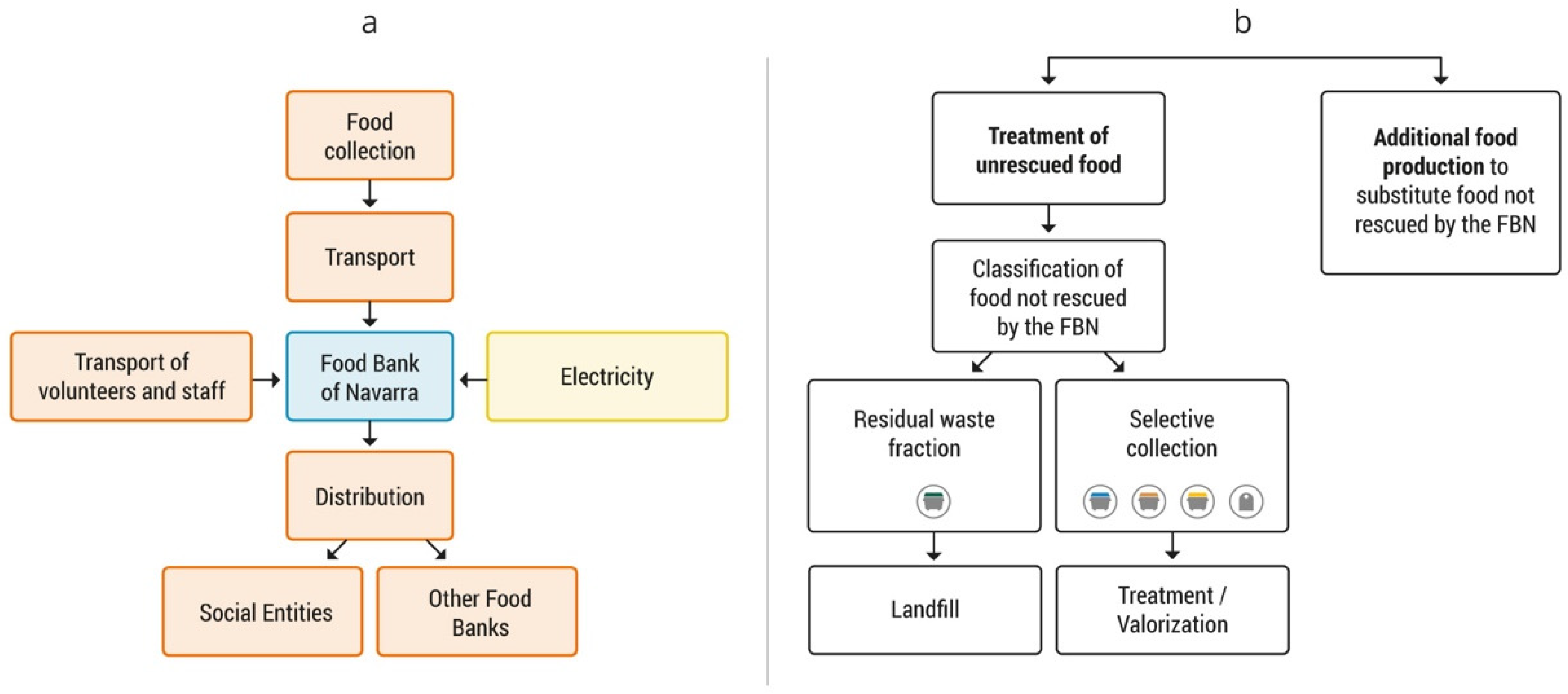
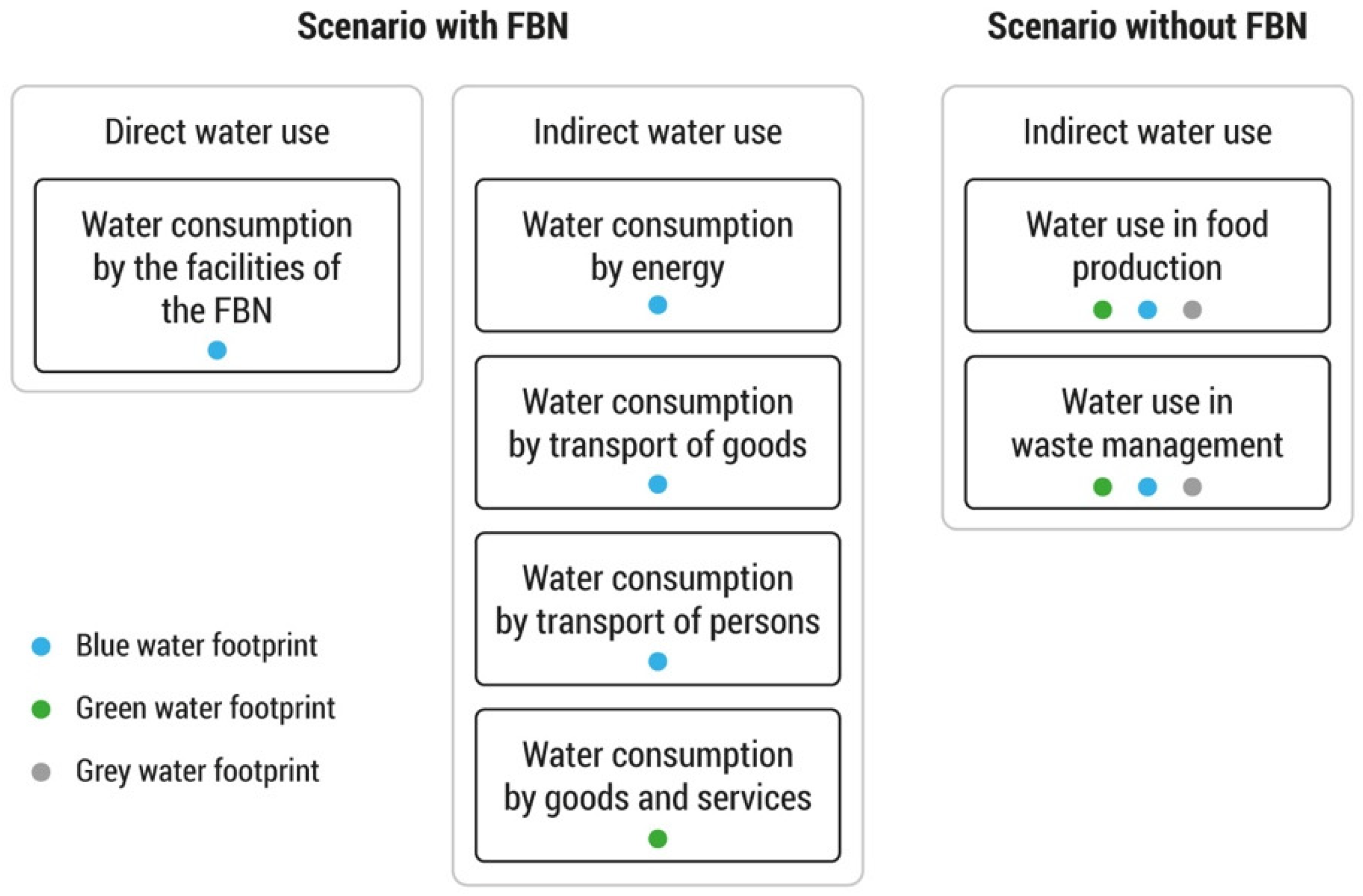
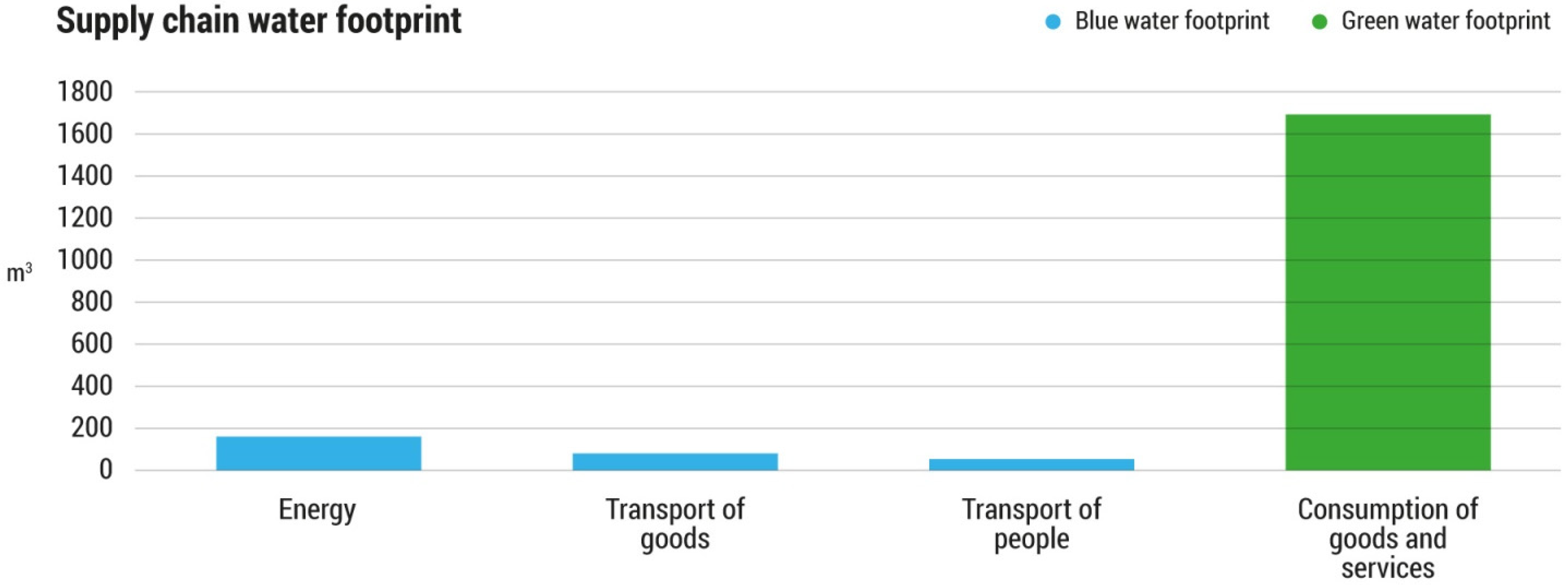
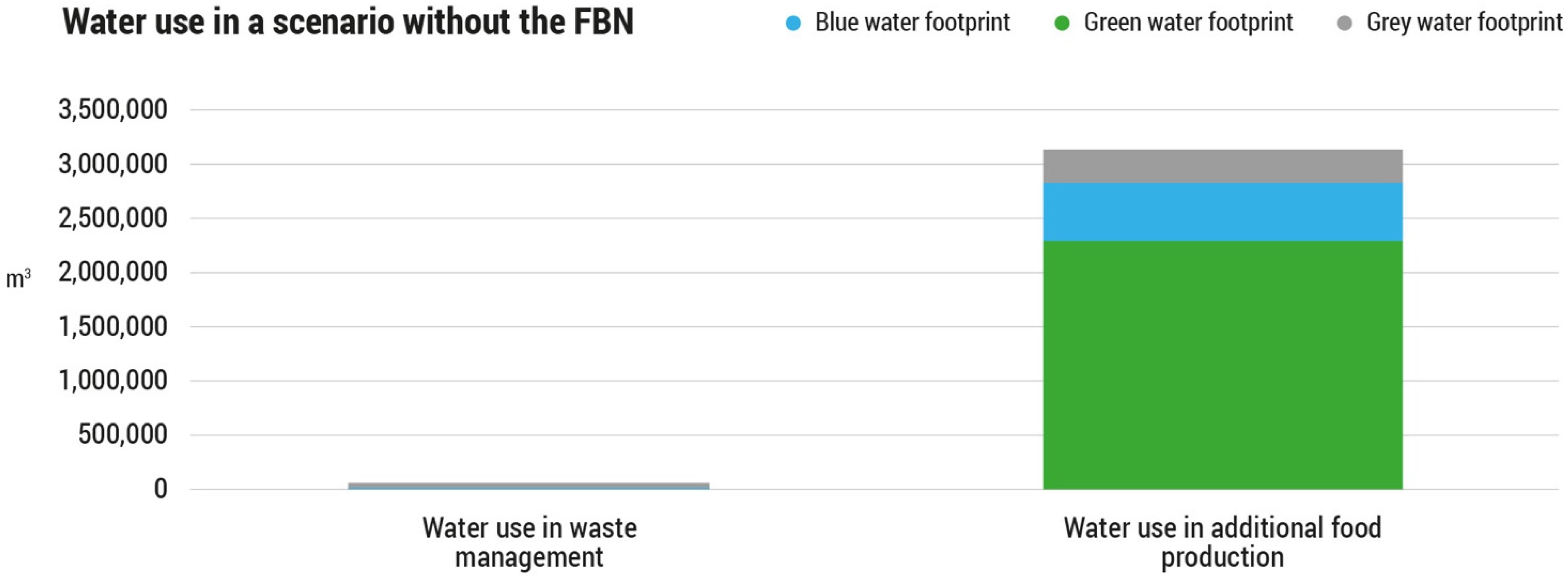
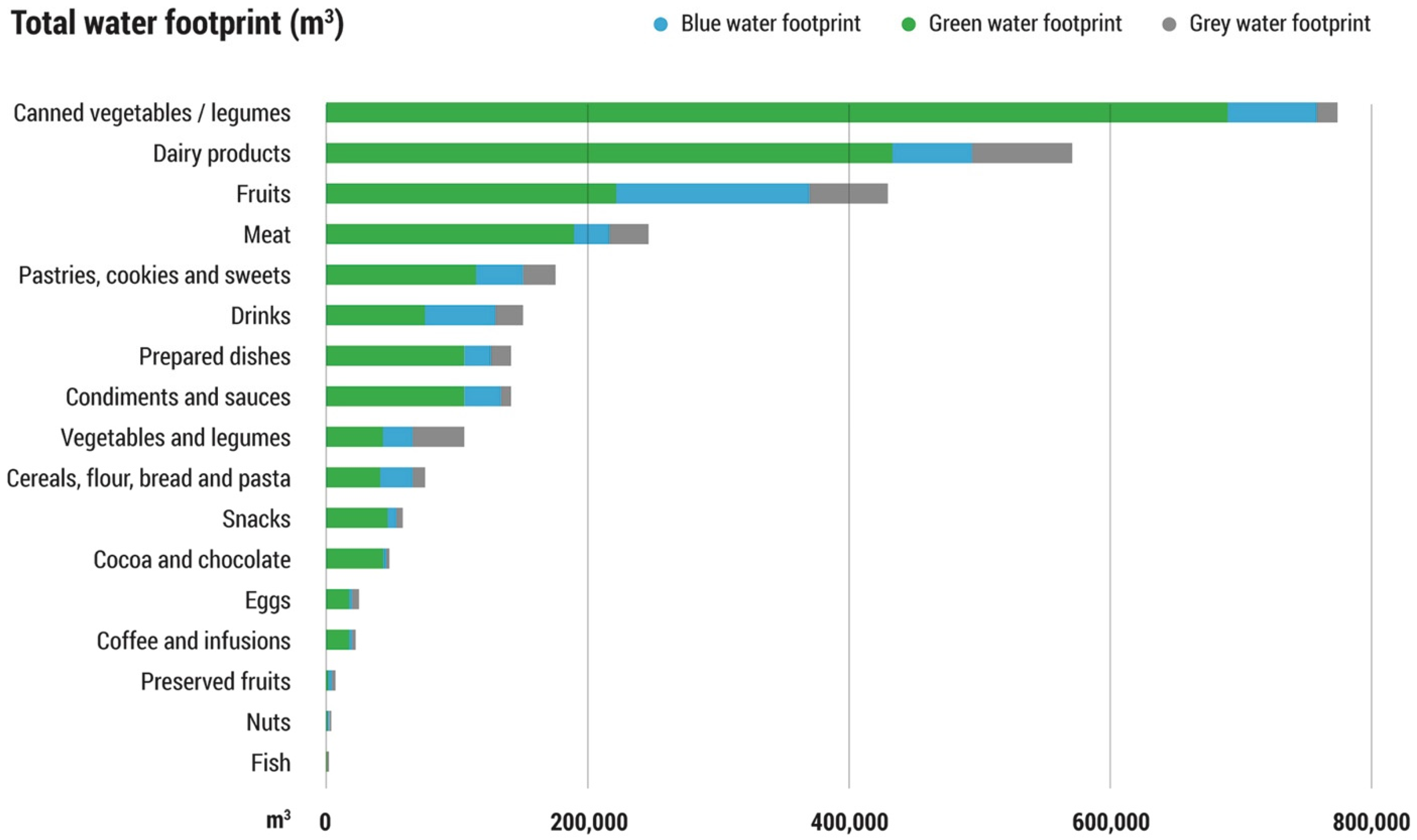
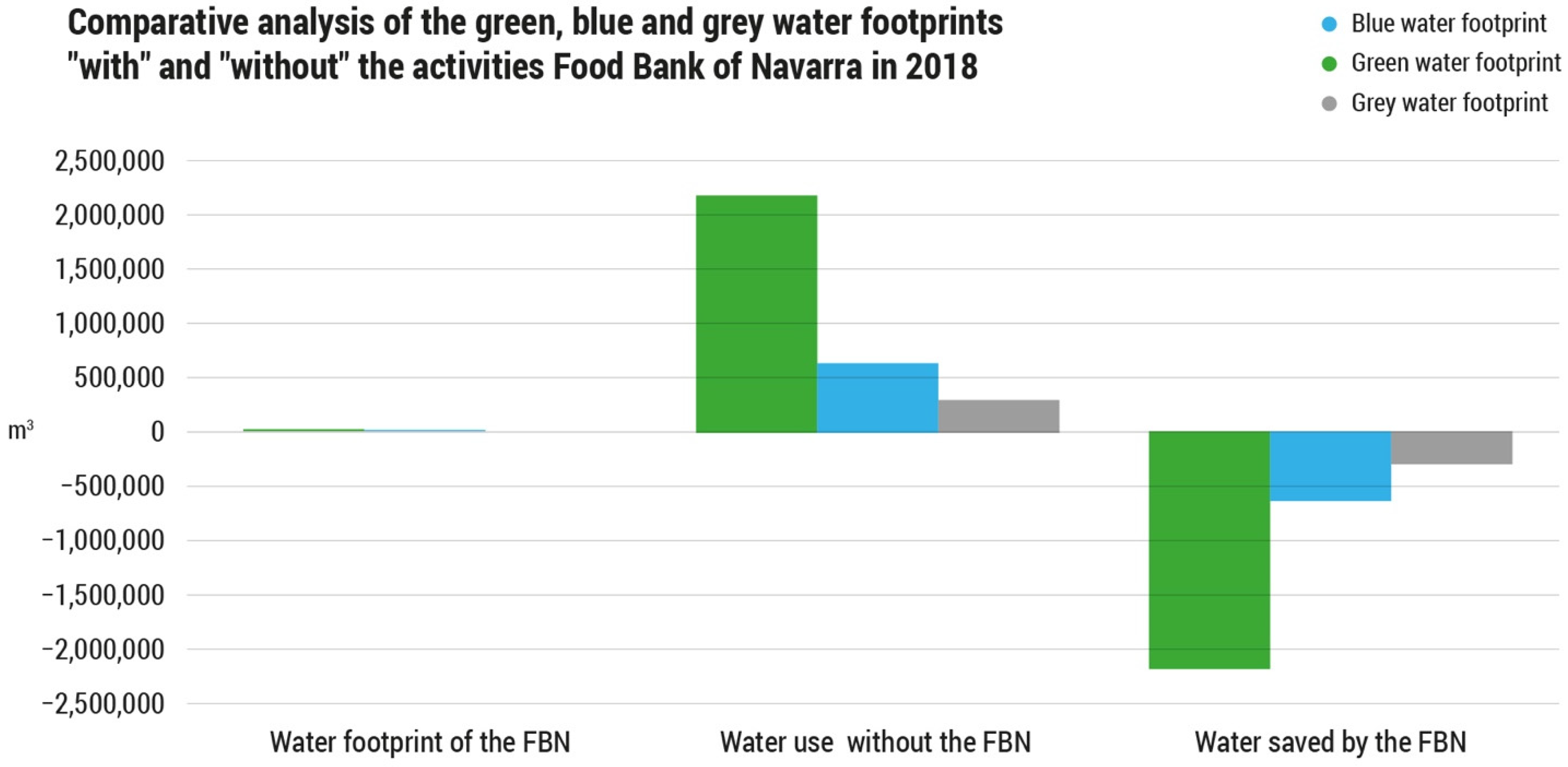
| Source of Consumption | Green WF (m3/year) | Blue WF (m3/year) | Grey WF (m3/year) | Total WF (m3/year) |
|---|---|---|---|---|
| Operational water footprint | ||||
| Facilities of the FBN Total operational water footprint | 0 0 | 0 0 | 0 0 | 0 0 |
| Supply chain water footprint | ||||
| Energy | 0 | 134 | 0 | 134 |
| Foodstuff transport | 0 | 67 | 0 | 67 |
| Personnel transport | 0 | 40 | 0 | 40 |
| Consumption of goods and services Total supply chain water footprint | 1685 1685 | 0 241 | 0 0 | 1685 1926 |
Publisher’s Note: MDPI stays neutral with regard to jurisdictional claims in published maps and institutional affiliations. |
© 2022 by the authors. Licensee MDPI, Basel, Switzerland. This article is an open access article distributed under the terms and conditions of the Creative Commons Attribution (CC BY) license (https://creativecommons.org/licenses/by/4.0/).
Share and Cite
Penalver, J.G.; Aldaya, M.M. The Role of the Food Banks in Saving Freshwater Resources through Reducing Food Waste: The Case of the Food Bank of Navarra, Spain. Foods 2022, 11, 163. https://doi.org/10.3390/foods11020163
Penalver JG, Aldaya MM. The Role of the Food Banks in Saving Freshwater Resources through Reducing Food Waste: The Case of the Food Bank of Navarra, Spain. Foods. 2022; 11(2):163. https://doi.org/10.3390/foods11020163
Chicago/Turabian StylePenalver, Josemi G., and Maite M. Aldaya. 2022. "The Role of the Food Banks in Saving Freshwater Resources through Reducing Food Waste: The Case of the Food Bank of Navarra, Spain" Foods 11, no. 2: 163. https://doi.org/10.3390/foods11020163
APA StylePenalver, J. G., & Aldaya, M. M. (2022). The Role of the Food Banks in Saving Freshwater Resources through Reducing Food Waste: The Case of the Food Bank of Navarra, Spain. Foods, 11(2), 163. https://doi.org/10.3390/foods11020163







